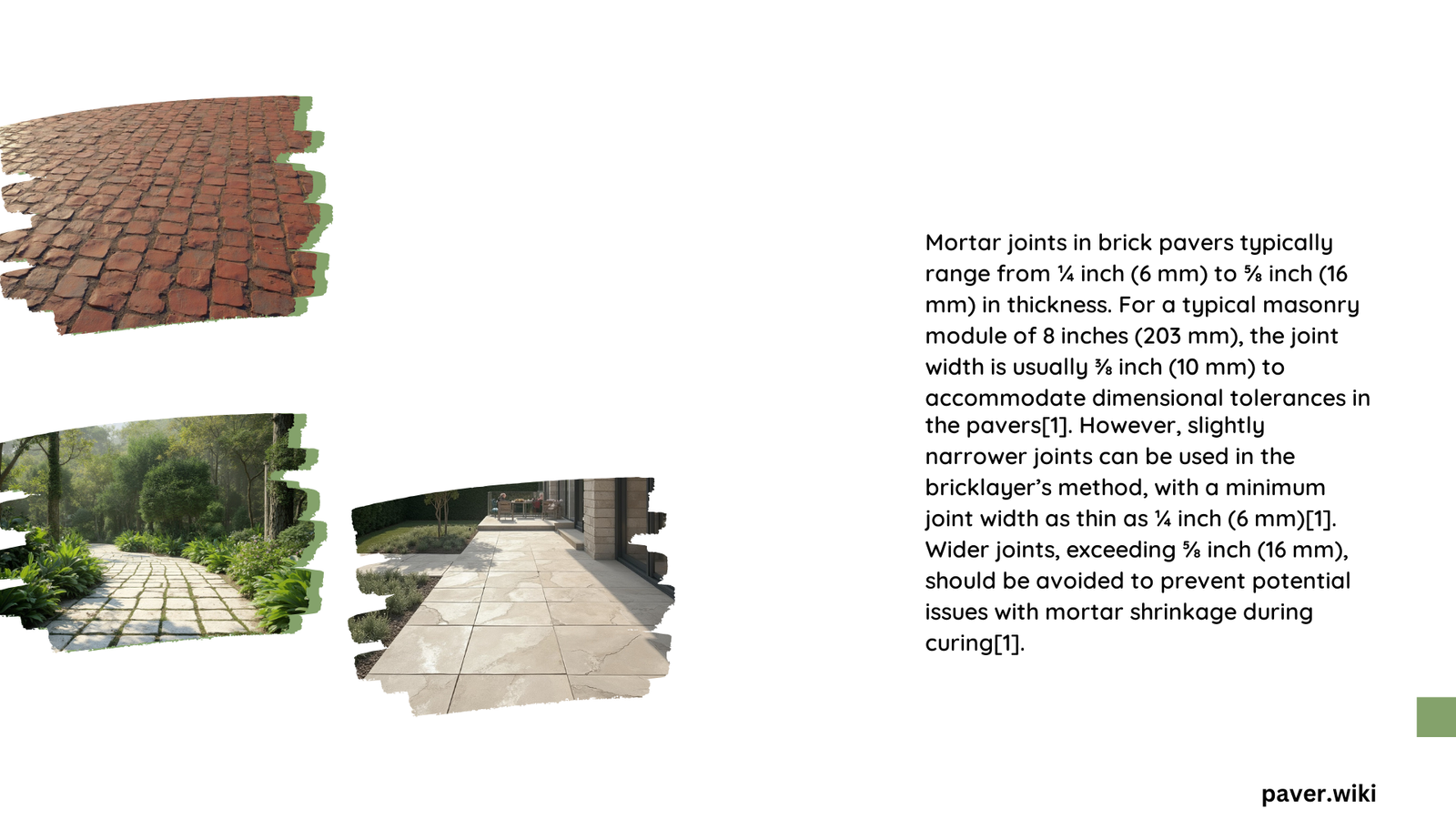Mortar joints in brick pavers typically range from 3/8 inch to 1/2 inch in thickness. The standard thickness, as specified by International Building Codes TMS 602, is 3/8 inch (0.38 inch). This size ensures optimal structural integrity and aesthetic appeal for most residential and light commercial applications. Proper joint thickness is crucial for the overall durability and performance of brick paver installations, affecting factors such as load distribution, moisture resistance, and visual appearance.
What Are the Standard Thicknesses for Mortar Joints in Brick Pavers?
The most common mortar joint thicknesses for brick pavers are:
- 3/8 inch (10 mm): This is the standard thickness specified by International Building Codes TMS 602.
- 1/2 inch (12.7 mm): Another widely used thickness, especially in certain applications.
- 1/4 inch (6 mm): Used in some installation methods, such as the bricklayer’s method.
It’s important to note that joints wider than 5/8 inch (16 mm) are generally avoided due to potential issues with mortar shrinkage.
Why Does Mortar Joint Thickness Matter in Brick Paver Installations?

The thickness of mortar joints in brick pavers is crucial for several reasons:
- Structural Integrity: Proper joint thickness ensures adequate load distribution and stability.
- Moisture Resistance: Well-filled joints help prevent water penetration and potential damage.
- Aesthetic Appeal: Consistent joint thickness contributes to a uniform and visually pleasing appearance.
- Flexibility: Appropriate thickness allows for slight movements and thermal expansion without cracking.
How Do Different Applications Affect Mortar Joint Thickness?
Mortar joint thickness can vary depending on the specific application:
| Application Type | Typical Joint Thickness | Considerations |
|---|---|---|
| Residential Walkways | 3/8 inch (10 mm) | Standard thickness for most pedestrian applications |
| Light Vehicular Traffic | 3/8 inch to 1/2 inch (10-12.7 mm) | May require slightly thicker joints for added stability |
| Heavy Vehicular Traffic | 3/8 inch to 1/2 inch (10-12.7 mm) | Requires reinforced base and setting bed |
| Decorative Patterns | 1/4 inch to 3/8 inch (6-10 mm) | Thinner joints may be used for intricate designs |
What Are the Benefits of Thicker Mortar Joints in Brick Pavers?
Thicker mortar joints offer several advantages in brick paver installations:
- Enhanced Structural Support: Thicker joints provide better load distribution and stability.
- Improved Flexibility: They can better accommodate slight movements and thermal expansion.
- Easier Installation: Thicker joints allow for more tolerance in paver placement.
- Better Moisture Resistance: More mortar means better protection against water penetration.
- Increased Durability: Thicker joints can withstand more wear and tear over time.
How Do You Properly Install Mortar Joints in Brick Pavers?
Proper installation of mortar joints is crucial for the longevity and performance of brick paver systems:
- Prepare the Base: Ensure a stable, well-compacted base layer.
- Apply Setting Bed: Lay a mortar setting bed no more than 2 feet ahead of paver placement.
- Place Pavers: Set pavers carefully, maintaining consistent joint spacing.
- Fill Joints: Completely fill joints with mortar or grout to minimize moisture penetration.
- Tool Joints: When mortar becomes thumbprint hard, tool joints for a proper seal.
- Allow Curing: Let the mortar cure fully before subjecting the surface to traffic.
What Are Common Mistakes to Avoid in Mortar Joint Installation?
When installing mortar joints in brick pavers, avoid these common pitfalls:
- Inconsistent Joint Width: Varying joint widths can lead to an unappealing appearance and structural issues.
- Overfilling or Underfilling: Joints should be filled completely but not overfilled, which can cause mortar to smear on paver surfaces.
- Improper Tooling: Failing to tool joints at the right time can result in weak or poorly sealed joints.
- Ignoring Weather Conditions: Extreme temperatures or moisture can affect mortar curing and performance.
- Neglecting Expansion Joints: Failing to include expansion joints can lead to cracking and shifting.
How Does Climate Affect Mortar Joint Thickness in Brick Pavers?
Climate plays a significant role in determining the optimal mortar joint thickness:
- Cold Climates: Thicker joints (up to 1/2 inch) may be preferred to accommodate freeze-thaw cycles.
- Hot Climates: Standard 3/8 inch joints are typically sufficient, but proper expansion joints are crucial.
- Wet Climates: Ensure joints are well-filled and sealed to prevent water penetration.
- Dry Climates: Standard joint thicknesses work well, but consider using mortar with added water retention properties.
What Are the Latest Trends in Mortar Joint Design for Brick Pavers?
Recent trends in mortar joint design for brick pavers include:
- Colored Mortar: Using tinted mortar to complement or contrast with paver colors.
- Textured Joints: Creating unique surface textures for added visual interest.
- Minimal Joint Width: Some designers opt for very thin joints (1/4 inch) for a sleek, modern look.
- Polymeric Sand: Using specialized sand products for enhanced joint stability and weed prevention.
- Sustainable Materials: Incorporating eco-friendly additives in mortar mixes for improved environmental performance.
In conclusion, understanding how thick mortar joints should be in brick pavers is crucial for successful installations. The standard 3/8 inch thickness provides an optimal balance of structural integrity, aesthetic appeal, and ease of installation for most applications. However, factors such as climate, traffic load, and design preferences may influence the choice of joint thickness. By following proper installation techniques and considering the specific requirements of each project, you can ensure durable and visually pleasing brick paver installations with appropriate mortar joint thicknesses.
References:
1. Brick Dimensions Guide: Common Shapes and Sizes – BigRentz
2. Paving Systems Using Clay Pavers in a Mortar Setting Bed – Brick Industry Association
3. Brick Dimensions & Sizes – Per Square Foot Chart – Glen-Gery
